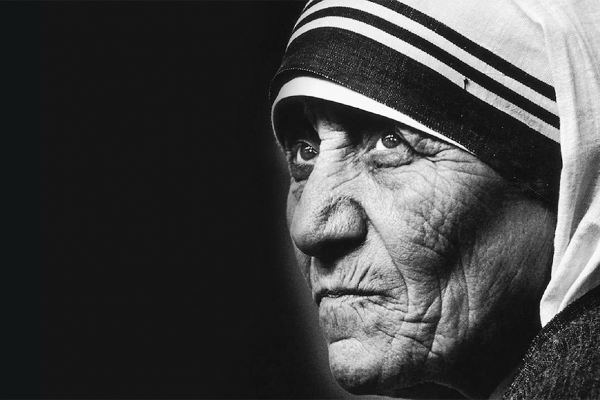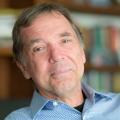THE BANNER HANGING from St. Peter’s Basilica in Rome showed Mother Teresa, hands clasped, looking out over the 100,000 faithful who had come to celebrate her sainthood. I was part of that crowd last September, and as I looked at that banner I couldn’t tell if her facial expression was a smile or a grimace.
In a museum a few blocks away were glass cases that displayed her sandals, her walking stick, and her blue and white sari, as well as letters, photos, and a timeline charting every major event in her life. In a different cathedral the night before, an orchestra and choir performed a magnificent original oratorio written in her honor.
Under the banner’s gaze at St. Peter’s, the hierarchy of the Catholic Church was seated, along with dignitaries from dozens of countries. I wondered what thought bubble would be most appropriate if one suddenly appeared above Mother Teresa’s depiction on the tapestry. I decided it would be this: “If you only knew.”
I was seated in a section with members of the Missionaries of Charity, the order Mother Teresa started in Kolkata, including a few from the U.S. who had met her and worked alongside her in different parts of the world. Most of the discussion before the Mass was about time they had spent with her. They served the poor with her; they washed feet; they touched the untouchables; they bathed and cared for the dying. They spoke of her boldness when she addressed national leaders, her challenge to businesses, churches, and countries to do more. Some claimed miracles as a result of invoking her intercession. One was hopeful that prayers to this newest saint would result in the healing of her son. Mother Teresa inspired them to serve those who are poor and hurting in their own communities.
Listening to all this, I thought she almost sounded like a superhero. Or a cliché.
‘Doubt is the only way to know anything’
Like those in my section, I was moved by her compassion and courage. But that’s not what really drew me to her. I was drawn by her doubt.
Throughout the celebratory Mass, my mind kept going to her book of letters to her spiritual advisers, where she repeatedly confessed her doubts and her experience of the absence of God for most of her time serving the poor in Kolkata. The book, Come Be My Light, was published in 2007, 10 years after her death.
Her experience of darkness caught her off guard, explained Brian Kolodiejchuk, who edited the letters. “Unable to feel His presence as she had earlier, she was bewildered and afraid. Was she going the ‘wrong way?’” he wrote. She perceived a call from God when she was 36 to leave her teaching post and serve the poor. That’s the last she heard from God.
Many believers have experienced a “dark night of the soul.” Few, I suspect, have had that dark night last 51 years.
The silence created “such terrible darkness within me,” she wrote, adding that “within me everything is icy cold,” and “If you only knew what goes on within my heart. Sometimes the pain is so great that I feel as if everything will break. The smile is a big cloak which covers a multitude of pains.”
Mother Teresa was able to believe in God with her intellect, explained Peter Rollins in his book Insurrection: To Believe is Human; To Doubt, Divine, “but she passed through the white-hot fires of forsakenness. She is, as such, a shining example of what it means to enter into the fundamental Christian event of Crucifixion.”
She accomplished a great deal in her lifetime, based on that encounter with God. She motivated thousands more to serve others, won a Nobel Peace Prize, and helped create chapters of the Missionaries of Charity in 139 countries. More than 4,500 people have taken the Missionaries’ vows of chastity, poverty, and obedience, with the additional vow of service to the poorest of the poor. They serve people dying of HIV/AIDS, leprosy, and tuberculosis, and run soup kitchens, dispensaries, mobile clinics, orphanages, and schools. Yet she was a world-class doubter.
In his book My Life With the Saints, James Martin wrote: “What remains clear is that Mother Teresa struggled intensely in her spiritual life. And this makes what she accomplished even more extraordinary and her example more meaningful to me. Her ministry, based as it was on a singularly intimate encounter with Jesus that would gradually fade into silence, whether lengthy or lifelong, is a remarkable testimony of fidelity.”
Doubt has played an important role throughout civilization. Jennifer Hecht’s book Doubt: A History takes us from Greek doubt to the present age. Jesus, from the cross, expressed doubt, Hecht wrote, when he exclaimed, “My God, why have you forsaken me?” “It sounds like he was expecting something that did not seem to be happening,” she wrote. In her description of Augustine, she said, “Even within the increasingly closed system of Christianity, doubt was understood as the only way to know anything.”
Paul Tillich said that “Doubt is not the opposite of faith; it is an element of faith.” Anne Lamott takes it a step further in her book Plan B. “The opposite of faith is not doubt, but certainty. Certainty is missing the point entirely. Faith includes noticing the mess, the emptiness and discomfort, and letting it be there until some light returns.” It’s also part of Zen thought, as is reflected in the phrase, “Great doubt: great awakening. Little doubt: little awakening. No doubt: no awakening.”
Superhero or villain?
The knowledge that Mother Teresa experienced profound doubt throughout her ministry actually enhanced the canonization experience for me. It made her less of a superhero, less of a cliché, less of a celebrity, and more of a complicated person who, when I thought about it, represented plenty of paradoxes.
And there’s nothing wrong with paradox. The Bible is full of them, such as the first shall be last, strength is found through weakness, power through humility, freedom through service, receiving by giving, victory over death by dying on a cross. Parker Palmer wrote an entire book on how the Christian life is pulled tight between what appear to be opposing points.
“Contradiction, paradox, the tension of opposites: These have always been at the heart of my experience, and I think I am not alone,” Palmer wrote in The Promise of Paradox. “I am tugged one way and then the other. My beliefs and my actions often seem at odds. My strengths are sometimes canceled by my weaknesses. My self, and the world around me, seem more a study in dissonance than a harmony of the integrated whole.”
Later in the book he described paradox by invoking physicist Neils Bohr, who said, “The opposite of a correct statement is a false statement. But the opposite of a profound truth may be another profound truth.”
Not everyone was a fan of Mother Teresa, of course. Christopher Hitchens was probably her most famous and aggressive antagonist. He produced a documentary on her called Hell’s Angel in 1994. In his 1995 pamphlet “The Missionary Position: Mother Teresa in Theory and Practice,” he described her as a demagogue, similar to moneygrubbing televangelists, providing PR cover for dictators such as Haiti’s Jean-Claude Duvalier and criminals such as Charles Keating by accepting their stolen money, and he criticized her stand against abortion and contraception.
“Her success is not, therefore, a triumph of humility and simplicity,” Hitchens wrote. “It is another chapter in a millennial story which stretches back to the superstitious childhood of our species, and which depends on the exploitation of the simple and the humble by the cunning and the single-minded.” He called her a “religious fundamentalist, a political operative, a primitive sermonizer, and an accomplice of worldly, secular powers.”
Yet the people I sat with at St. Peter’s Square were all involved in some kind of service to the poor as a direct result of their encounters with this saint. They met her, were inspired by her, and in some cases were admonished by her, blessed by her, and moved by her to feed the hungry, visit the sick and imprisoned, shelter the homeless, and give water to the thirsty—because they took her at her word that when they did small things with great love, they were doing them for, and even to, Jesus.
This struck me as a paradox.
‘Get out of here! Go love your neighbor.’
A few years ago I had lunch with Dr. Paul Farmer, one of the founders of Partners in Health, widely known for his work to eradicate disease in Haiti, Rwanda, Peru, and elsewhere. Our conversation turned to Mother Teresa and the hospice she opened, the “home for the dying destitutes.” I know people who have volunteered there, and their lives were changed as a result of the experience. Farmer visibly bristled when I mentioned her, and I asked why. He acknowledged that it wasn’t a popular position to criticize her, but he got worked up as he described the unsanitary conditions of the facility, wondered why more of the money donated wasn’t spent on medicine or at least on alleviating pain, and questioned why many of the suffering people in her facilities weren’t visited by doctors or brought to hospitals.
I suggested that perhaps she saw her role as giving people dignity and love as they were dying. At this Farmer pounded his fist on the lunch table and exclaimed for all the restaurant to hear, “But they didn’t all have to die!”
In his homily at the canonization, Pope Francis said that Mother Teresa was, in all aspects of her life, “a generous dispenser of divine mercy, making herself available for everyone through her welcome and defense of human life, those unborn and those abandoned and discarded.” He said, “She bowed down before those who were spent, left to die on the side of the road, seeing in them their God-given dignity. She made her voice heard before the powers of this world, so that they might recognize their guilt for the crime—the crimes!—of poverty they created.”
I focused again on the banner. I tried not to think of those who were begging in the streets of Rome, who I had to ignore, or step over, on my way to St. Peter’s. I tried not to get distracted by the refugee crisis that was occurring throughout Europe at that very hour—including the shores of Italy—as “the least of these” tried to flee one kind of life for the promise of another kind of life and ended up in filthy camps penned in by barbed wire, or at the bottom of the ocean. The waters of the Mediterranean Sea are as littered with the unwanted as are the alleys of Kolkata. I tried not to think about the representatives from governments whose policies were creating this diaspora, who were seated just a few feet from the pope who was exhorting us all to live more like Mother Teresa, and who were even more closely under her banner’s gaze.
I tried to think, instead, about the difference Mother Teresa made in the lives of so many, and on the model of compassion and courage she portrayed to the world.
I tried, but I failed.
I turned to the woman next to me—a handbag designer from Manhattan who had worked alongside Mother Teresa when she visited the South Bronx—and said, “If that banner could talk, what would Mother Teresa tell us right now?”
The designer didn’t hesitate.
“She’d say, ‘What are you doing just sitting here? Why aren’t you serving the poor? Why did you go to all of this expense instead of using the money to serve others? Get out of here! Have you learned nothing from me? Go love your neighbor.’”
And yet, there we sat, in the swelter of mid-afternoon, paying our respects to someone who would have been offended by the gesture.
I looked at that banner again and focused on her expression. Smile or grimace?
Both.

Got something to say about what you're reading? We value your feedback!

